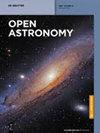利用Hinode SOT/SP数据进行速度场分析的可能性
IF 0.5
4区 物理与天体物理
Q4 ASTRONOMY & ASTROPHYSICS
引用次数: 0
摘要
摘要揭示了利用平分线分析法分析Hinode SOT/SP地图各点视距速度及其梯度的可能性。描述了一种获得这种梯度的技术。为了估计速度梯度,必须同时知道速度值和等分点响应的层高。我们已经构建并测试了一种方法来确定这个高度。我们发现在相同高度的速度线Fe I λ 6301, 6302 Å平均在整个地图上。结果是这些速度有一些随高度和时间变化的差异。整个地图的平均速度估计误差为2 m·s−1。由此可见,NIST表格中给出的6301和6302线的波长可能与实际波长5.5 mÅ有所不同。或者在FITS文件中指定的光谱仪色散不准确。以整幅图的点和最热点和最冷点的子集为例,分别构建了随LOS速度高度及其梯度的变化曲线。本文章由计算机程序翻译,如有差异,请以英文原文为准。
Possibilities of velocity field analysis from Hinode SOT/SP data
Abstract The possibility of analyzing the line of sight (LOS) velocity and its gradient at each point of the Hinode SOT/SP maps using bisector analysis is revealed. A technique for obtaining such gradient is described. To estimate the velocity gradient, it is necessary to know both the velocity value and the layer height to which the bisector point is responded. We have constructed and tested a method to determine this height. We found velocities at the same heights for lines Fe I λ 6301, 6302 Å averaged over the whole map. It turned out that these velocities have some difference that changes with height and time. The error in the estimating of average velocity for the whole map is 2 m·s−1. It follows that the wavelengths of lines 6301 and 6302 given in the NIST tables may differ from the real ones at 5.5 mÅ. Or there is an inaccuracy in the spectrograph dispersion specified in the FITS files. As an example, the curves of changes with the height of the LOS velocity and its gradient were constructed both for points of the whole map and for subsets of the hottest and coldest points.
求助全文
通过发布文献求助,成功后即可免费获取论文全文。
去求助
来源期刊

Open Astronomy
Physics and Astronomy-Astronomy and Astrophysics
CiteScore
1.30
自引率
14.30%
发文量
37
审稿时长
16 weeks
期刊介绍:
The journal disseminates research in both observational and theoretical astronomy, astrophysics, solar physics, cosmology, galactic and extragalactic astronomy, high energy particles physics, planetary science, space science and astronomy-related astrobiology, presenting as well the surveys dedicated to astronomical history and education.
 求助内容:
求助内容: 应助结果提醒方式:
应助结果提醒方式:


